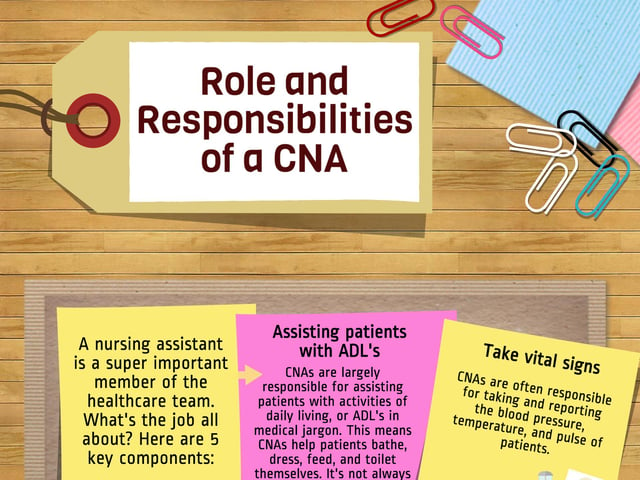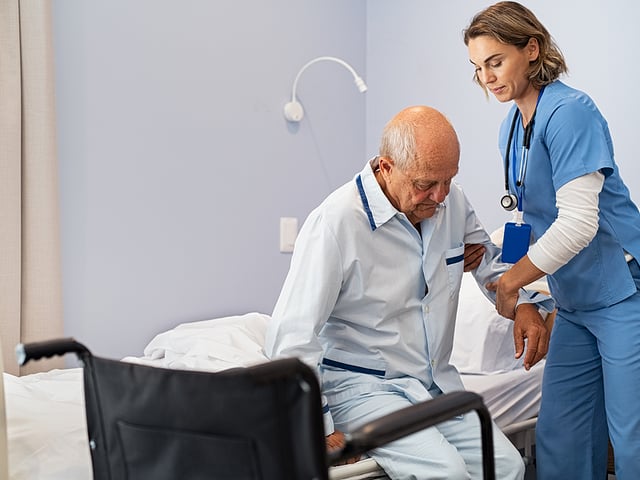
The Role and Responsibilities of a CNA
Becoming a Certified Nursing Assistant (CNA) is both a challenging and rewarding career choice. As the primary caregivers in many healthcare settings, CNAs play a vital role in ensuring patient care and comfort. Let’s delve into the key roles and responsibilities of a CNA to provide students with a comprehensive understanding of what to expect in this profession.
Assisting Patients with Activities of Daily Living (ADLs)
Activities of Daily Living, commonly referred to as ADLs, are the essential tasks that most individuals perform on a daily basis for self-care. For many patients, particularly the elderly or those recovering from surgeries or illnesses, these tasks can become challenging. CNAs play a crucial role in assisting with these activities, ensuring that patients can comfortably and safely go about their daily routines. Let’s break down these ADLs in more detail:
Bathing
Ensuring a patient is clean is not just about maintaining appearances or odors; it’s crucial for overall health. Proper hygiene can prevent infections, improve mental well-being, and offer a sense of normalcy. CNAs are trained to:
-
Assist with full or partial baths depending on the patient’s needs and mobility.
-
Ensure privacy and dignity by using curtains or drapes.
-
Monitor water temperature to ensure it’s comfortable and safe.
-
Use special equipment or techniques for patients with specific conditions, ensuring they’re bathed without causing harm or discomfort.
Dressing
Clothing is a significant component of our identity and how we present ourselves to the world. For patients, the simple act of getting dressed can restore a sense of self. CNAs:
-
Help select weather-appropriate and comfortable clothing.
-
Provide assistance with buttons, zippers, or other fasteners that might be challenging for patients.
-
Offer support for patients with limited mobility, ensuring they don’t strain or hurt themselves.
Feeding
Nutrition is paramount for healing and maintaining good health. CNAs play a vital role in ensuring patients receive adequate nourishment by:
-
Assisting with feeding, especially for patients with coordination or swallowing difficulties.
-
Monitoring food and fluid intake, ensuring patients are hydrated and noting any appetite changes.
Toileting
While this is a sensitive aspect of care, it’s indispensable for maintaining a patient’s dignity and health. CNAs:
-
Help patients safely navigate to the restroom, providing support or steadying them if necessary.
-
Assist with the use of bedpans or urinals for patients who can’t leave their beds.
-
Provide care with compassion, understanding the potential embarrassment or discomfort patients might feel.
-
Maintain cleanliness to prevent the spread of infections or illnesses.
Mobility
Maintaining or improving mobility can be crucial for a patient’s physical and mental health. CNAs:
-
Support with walking, which can include providing a steadying arm or using assistive devices like walkers.
-
Assist in transfers, for instance, from the bed to a wheelchair or from a chair to a standing position.
-
Conduct passive or active range-of-motion exercises, ensuring that immobile patients maintain joint flexibility and muscle strength.
-
Reposition bedridden patients regularly to prevent bedsores and improve circulation.
The role of CNAs in assisting with ADLs is monumental. They offer not just physical support but also emotional and mental comfort, ensuring that patients feel cared for, dignified, and respected in their most vulnerable moments.
Monitoring and Reporting Vital Signs
By meticulously monitoring patients’ vital signs, CNAs offer a crucial first line of insight into a patient’s physiological condition. These measurements, paired with a CNA’s detailed reporting, ensure that potential medical issues are identified and addressed promptly.
Blood Pressure Monitoring
Blood pressure is an essential measure of cardiovascular health. Using a sphygmomanometer, CNAs gauge the force of blood against the artery walls. The process involves inflating a cuff on the patient’s arm and listening with a stethoscope to determine the systolic and diastolic pressures. Regular checks can highlight concerns such as hypertension or potential heart-related problems.
Temperature Measurements
Body temperature gives a snapshot of the body’s thermoregulation. Depending on the patient’s condition and the clinical setting, CNAs might use oral, ear, or other thermometers. Monitoring body temperature is crucial as fluctuations can be indicators of infections, inflammation, or broader systemic issues like hypothermia.
Pulse and Respiration Rates
The heart and lungs’ functional status is deduced from pulse and respiration rates. CNAs check the pulse by placing their fingers on a patient’s wrist or neck, counting the heartbeats over a minute. An irregular pulse can be a red flag for heart issues. Similarly, by silently observing a patient’s breaths for a minute, CNAs gauge their respiratory rate, helping identify potential respiratory diseases or complications with medications.
Oxygen Saturation
Oxygen saturation levels provide insights into how well hemoglobin is ferrying oxygen in the blood. This is typically measured using a pulse oximeter. A lower-than-normal reading could be a warning sign of conditions like respiratory distress or chronic diseases like COPD or asthma.
Reporting and Communication
Beyond just the act of monitoring, CNAs’ responsibilities extend to accurate documentation and communication. Vital signs are diligently recorded in patient charts with all necessary details. Any deviation from established norms is promptly relayed to the nursing team or physicians. In situations of acute concern, CNAs are trained to initiate rapid response measures, emphasizing their pivotal role in the healthcare continuum.
Ensuring a Safe and Pleasant Environment
The ambiance and safety of healthcare settings are crucial for patients’ recovery and well-being. While doctors and nurses focus on direct medical care, Certified Nursing Assistants (CNAs) are often the ones who ensure that the environment supports healing, both physically and mentally. Their responsibilities in this regard are manifold.
Room Maintenance: More than Just Cleaning
A clean room isn’t just about aesthetics; it’s vital for infection control. CNAs frequently handle:
Changing Soiled Sheets: This is not just about patient comfort. Fresh linens reduce the risk of infections and skin issues for bed-bound patients.
Tidying Up: By organizing personal items, removing clutter, and ensuring that equipment is stored properly, CNAs help reduce distractions and stress for the patient.
Disinfecting Surfaces: Regular wiping down of high-touch surfaces like bedside tables, call buttons, and railings helps in preventing the spread of germs.
Comfort Measures: Personalizing Patient Spaces
Comfort is integral to healing. CNAs ensure:
Temperature Control: Recognizing that each patient’s comfort level might vary, CNAs adjust room temperatures to suit individual preferences, considering factors like age, medical conditions, or ongoing treatments.
Accessibility of Items: Whether it’s a glass of water, a remote control, or a personal belonging, CNAs ensure that patients can access items without straining or risking a fall.
Lighting Management: Depending on the time of day or the patient’s condition (e.g., migraines or light sensitivity), CNAs adjust lighting to create a conducive healing environment.
Safety Checks: Proactive Hazard Management
Ensuring a safe environment is paramount. CNAs are trained to:
Check Bed Rails: They ensure bed rails are secure to prevent patients from accidentally rolling off the bed.
Monitor Floor Conditions: Wet floors can be a slipping hazard. CNAs promptly clean up any spills and use “Wet Floor” signs when necessary.
Minimize Clutter: By organizing equipment, personal items, and ensuring clear pathways, CNAs reduce tripping hazards and make it easier for other healthcare professionals to access the patient quickly during emergencies.
In essence, while CNAs may not always be in the limelight, their behind-the-scenes efforts in maintaining a safe and pleasant environment significantly impact patient comfort and recovery. They bridge the gap between clinical care and holistic well-being.
Providing Emotional Support and Companionship
Healthcare is not solely about addressing physical ailments; it encompasses treating the whole person, which includes their emotional and mental well-being. While CNAs are often celebrated for their hands-on clinical roles, their contributions in providing emotional support and companionship to patients are equally vital. These acts of kindness and understanding often serve as a beacon of hope and comfort for those under their care.
Active Listening: More than Just Hearing
Patients, especially those in prolonged care, often bear emotional burdens. Sometimes, what they need most is someone to share these with:
-
Being Present: CNAs provide more than just physical presence; they offer emotional availability. They are there for patients, tuning into their feelings, even when words aren’t spoken.
-
Acknowledging Concerns: Whether it’s anxiety about a procedure, sadness about a diagnosis, or simply a story from their past, CNAs listen without judgment, validating patients’ feelings and experiences.
Engagement: Fostering Connections and Alleviating Loneliness
Loneliness can be a silent adversary for many patients. CNAs combat this by:
-
Initiating Conversations: Sometimes, a simple chat about the weather, a book, or a shared hobby can uplift a patient’s spirits.
-
Activity Participation: Whether it’s assisting with a crossword puzzle, watching a favorite show together, or indulging in some light bedside hobbies, CNAs engage in activities that resonate with the patient, fostering a sense of normalcy and connection.
Advocacy: Standing Up for Those in Their Care
Patients, especially those who are critically ill or facing cognitive challenges, may struggle to voice their needs, concerns, or preferences. Here’s where CNAs step in as staunch advocates:
-
Recognizing Unspoken Needs: CNAs, through their close interactions, often pick up on non-verbal cues or subtle changes in behavior, hinting at discomfort, pain, or unmet needs.
-
Facilitating Communication: If a patient is hesitant or unable to speak about certain concerns, CNAs can act as intermediaries, ensuring that the medical team is informed, and the patient’s wishes are respected.
-
Protecting Patient Rights: CNAs ensure that patients are treated with dignity, privacy, and respect, and they actively participate in safeguarding these rights.
Observing and Reporting Changes in Patient Condition
The frequent and close interactions that CNAs share with patients place them in a unique position to detect early signs of health changes. Often, it’s the subtlest shifts in behavior or appearance that indicate a brewing issue. The timely observation and subsequent communication by CNAs can make a significant difference in the patient’s outcome, ensuring timely interventions and treatments.
Monitoring for Physical Signs
Physical manifestations can often be early indicators of an underlying health issue. CNAs are trained to:
Detect Distress or Pain: Whether it’s a slight grimace when moving, a change in posture, or vocal expressions of discomfort, CNAs are adept at identifying signs that a patient might be in pain or distress. This can be especially critical in patients who might not verbally express their discomfort.
Spot Unexpected Symptoms: Observing unusual physical symptoms like swelling in limbs, discoloration of skin or nails, or the sudden appearance of rashes is within a CNA’s purview. These can be indicators of reactions to medications, infections, or other health complications.
Behavioral and Cognitive Observations
Changes in a patient’s behavior or cognitive function can be just as telling as physical symptoms:
Behavioral Shifts: A usually talkative patient becoming withdrawn, or a calm patient becoming agitated, can be flags for CNAs. Such behavioral changes can hint at factors ranging from medication side effects to emotional distress.
Cognitive Changes: If a patient starts showing signs of confusion, memory lapses, or disorientation, it’s vital to take note. These can be signs of conditions like delirium, reactions to certain medications, or even the progression of neurodegenerative diseases.
Swift Communication: The Key to Effective Care
Recognizing changes is just the first step. The value of these observations lies in their timely communication:
Regular Updates: CNAs ensure that any and all observations, even if they seem minor, are documented in the patient’s chart. This provides a comprehensive view of the patient’s health trajectory.
Immediate Reporting: Should a CNA observe a significant or concerning change in a patient’s condition, they are trained to promptly notify the appropriate medical staff, be it nurses, doctors, or specialists. This swift communication ensures that necessary interventions can be initiated without delay.
Embracing the Vital Role of a CNA: Your Journey Begins Here
The Certified Nursing Assistant (CNA) role is a linchpin in the vast machinery of the healthcare industry. These professionals bridge the gap between patients and medical staff, offering both clinical support and compassionate care. While the tasks and responsibilities might appear diverse, they all converge towards one primary objective: enhancing patient well-being and comfort.
For those aspiring to don the role of a CNA, preparation is key. Our collection of practice tests, comprehensive study guides, and handy flashcards have been meticulously crafted to help you navigate the CNA exam with confidence. With these tools at your disposal, you’ll not only be equipped to ace the test but also to embark on a meaningful journey in healthcare.
In conclusion, the role of a CNA is truly multifaceted and indispensable. As you prepare to step into this noble profession, remember that while the path is demanding, the impact you can make on patients’ lives is immeasurable. Use our resources to fortify your knowledge, and let your passion for caregiving guide you towards a rewarding career.

Keep Reading

Certified Nursing Assistant Exam Blog
How Long Does it Take to Become a CNA?
As a profession on the frontline of healthcare, Certified Nursing Assis…

Certified Nursing Assistant Exam Blog
How to Do Well on the CNA Skills Test
Over 1.3 million nursing assistants work in our healthcare system today…

Certified Nursing Assistant Exam Blog
What Does a Nursing Assistant (CNA) Do?
Are you interested in exploring medical careers? The healthcare industr…